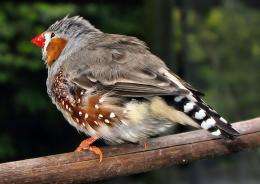July 17, 2012 report
Research team finds zebra finches learn to vocalize in ways similar to humans

(Phys.org) -- In the quest to better understand how people learn to communicate, researchers have focused on different parts of the brain. In so doing, they’ve discovered two parts in particular that are involved in language processing and speech vocalization: Wernicke’s and Broca’s area respectively. Now new research shows that a type of songbird, the zebra finch, has analogous regions in its brain. The first called the NCM appears to be involved in processing the songs of its father when young, while the HVC is involved in song vocalization in finches of all ages.
The researchers, from the US and the Netherlands, as they describe in their paper published in the Proceedings of the National Academy of Sciences, found that while still young, zebra finches show increased neural activity in the left side of their brain (in the NCM) when hearing songs from their father than when hearing songs from other birds or are exposed to no noise at all.
In their study the team exposed two groups of zebra finches, adults and adolescents, to songs sung by their fathers, songs by other birds, and no songs at all. While doing so they also monitored their brain activity. They found that the HVC for birds of both ages was more active in the left hemisphere regardless of which songs they were exposed to, which wasn’t a surprise because it’s the part of the brain they suspected was involved in singing, not learning their songs. The NCM, on the other hand, showed very clear differences when responding to the sound of their father singing, though that difference was much more pronounced in the adolescent birds. They also found a correlation between NCM activity and how well the young birds were able to mimic their father’s song, the better they were, the more left hemisphere dominance there was.
The researchers speculate that the similarities between the way humans and finches appear to learn to communicate are an example of convergent evolution, which is where animals of different species develop the same ways of doing things independently. Surprisingly, they note, the closet relative to humans, apes and monkeys, don’t appear to learn to communicate in the same way at all, but rather are born with their vocalizations.
More information: Human-like brain hemispheric dominance in birdsong learning, PNAS, Published online before print July 16, 2012, doi: 10.1073/pnas.1207207109
Abstract
Unlike nonhuman primates, songbirds learn to vocalize very much like human infants acquire spoken language. In humans, Broca’s area in the frontal lobe and Wernicke’s area in the temporal lobe are crucially involved in speech production and perception, respectively. Songbirds have analogous brain regions that show a similar neural dissociation between vocal production and auditory perception and memory. In both humans and songbirds, there is evidence for lateralization of neural responsiveness in these brain regions. Human infants already show left-sided dominance in their brain activation when exposed to speech. Moreover, a memory-specific left-sided dominance in Wernicke’s area for speech perception has been demonstrated in 2.5-mo-old babies. It is possible that auditory-vocal learning is associated with hemispheric dominance and that this association arose in songbirds and humans through convergent evolution. Therefore, we investigated whether there is similar song memory-related lateralization in the songbird brain. We exposed male zebra finches to tutor or unfamiliar song. We found left-sided dominance of neuronal activation in a Broca-like brain region (HVC, a letter-based name) of juvenile and adult zebra finch males, independent of the song stimulus presented. In addition, juvenile males showed left-sided dominance for tutor song but not for unfamiliar song in a Wernicke-like brain region (the caudomedial nidopallium). Thus, left-sided dominance in the caudomedial nidopallium was specific for the song-learning phase and was memory-related. These findings demonstrate a remarkable neural parallel between birdsong and human spoken language, and they have important consequences for our understanding of the evolution of auditory-vocal learning and its neural mechanisms.
Journal information: Proceedings of the National Academy of Sciences
© 2012 Phys.org



















